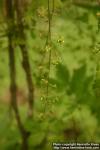
 The rhizome and roots of Xanthorrhiza (Zanthorhiza) apiifolia, L'Heritier (Xanthoriza simplicissima, H. Marshall; Marbosia tinctoria, Wm. Bartram; Xanthorrhiza tinctoria, Woodhouse).
The rhizome and roots of Xanthorrhiza (Zanthorhiza) apiifolia, L'Heritier (Xanthoriza simplicissima, H. Marshall; Marbosia tinctoria, Wm. Bartram; Xanthorrhiza tinctoria, Woodhouse).
Nat. Ord.—Ranunculaceae.
COMMON NAMES: Shrub yellow root, Southern yellow root, American shrub yellow root, Parsley-leaved yellow root, Yellow wort, and Yellow root.
ILLUSTRATION: Lloyd's Drugs and Med. of N. A., Pl. 25; Bentley and Trimen, Med. Plants, 9.
Botanical Source.—This is a small, deciduous, indigenous shrub, 1 to 3 feet in height, with a thick, horizontal, deep-yellow rhizome, throwing up numerous suckers. The stem is short, woody, leafy above, with a light-gray (Lloyd) bark, and a bright-yellow wood. The leaves are pinnate, of about 3 pairs with an odd one, glabrous, about 8 inches long, including the long petioles; they are 2 or 3 inches long, ovate or rhomboidal, sessile, incisely-lobed, and dentate, sometimes divided almost to the base on one side, pale-green, smooth above and slightly pubescent beneath. The flowers are small, dull purplish-brown, in axillary, compound, drooping racemes, appearing with the leaves. Calyx of 5 sepals, regular, spreading, and deciduous; corolla of 5 obovate, concave, 2-lobed petals, smaller than the sepals, and raised on a claw. Ovaries from 5 to 9. Follicles or capsules inflated, compressed, spreading, 1 ½ inches long, 1-celled, 2-valved, and opening at the apex; seeds, oval-and flattened (L.—W.—G.).
History and Description.—This plant is found along river banks in the mountains of Pennsylvania to Florida, being chiefly confined to the mountains. It is also found in some of the western and southwestern states, flowering in March and April. The root is the medicinal part; it varies in length from 4 to 12 inches, is about 6 lines in diameter, is bright-yellow (light-brown when dried), and exceedingly bitter. Water extracts its virtues, and sulphate of iron is not incompatible with its infusion. The bark of the stem is equally as efficient as the root. The Indians were well acquainted with it as a dye; it dyes silk a bright-yellow, and wool a dark-brown or dun color. The plant is generally known in the South as yellow root, a name borne farther north by hydrastis.
Chemical Composition.—The root contains berberine, to which undoubtedly its tonic properties are due. The presence of this principle was suspected in the drug by Wm. S. Merrell, it was isolated by G. Dyson Perrins (Pharm. Jour. and Trans., May, 1862), who obtained but a very small amount of it. J. U. Lloyd obtained, on a large scale, 1.1 per cent of berberine monosulphate. Gum and bitter resin were early pointed out by Dr. Woodhouse (see Lloyd's Drugs and Med. of N. A., Vol. I, p. 297). Mr. Samuel S. Jones (Amer. Jour. Pharm., 1886, p. 161) made a complete quantitative analysis of the root. In addition to starch, dextrin, sugars, etc., be found several resins, and 0.28 per cent of total alkaloids. In the mother liquor from berberine sulphate, the author found an amorphous alkaloid not identical with berberine.
Action, Medical Uses, and Dosage.—Yellow root is a pure, bitter tonic, considered by the late Prof. Barton to be superior to calumba. It may be used for all purposes in which the other simple tonic bitters are applicable. Of xanthorrhiza, Prof. J. U. Lloyd (Drugs and Med. of N. A., Vol. I, p. 289) very justly remarks that "although we find xanthorrhiza most favorably introduced by the leaders of medicine of the early part of the century, and although it has been official in the Pharmacopoeia since its first issue (1820) until discarded in 1880, it has failed to obtain a foothold. It has never been a favorite with either botanic or Eclectic physicians, and it is hardly recognized by them. In this connection we must revert to the fact that, although known to the Eclectics, and possessing berberine in nearly as great proportion as hydrastis, they persistently refused to use it in place of that drug, asserting that its action was not at all similar. The investigations of Profs. Bartholow, Sattler, Shoemaker, and others (see Hydrastis, in Drugs and Med. of N. A.), now show that these conclusions were rational, as at least one of the very active principles of hydrastis is entirely absent from Xanthorrhiza." Dose of the powder, 20 to 40 grains, 3 times a day; of the decoction, 1 or 2 tablespoonfuls; of the tincture, which is its most eligible form, from 1 to 3 fluid drachms. It contains a bitter resin, which would probably form an excellent tonic.

